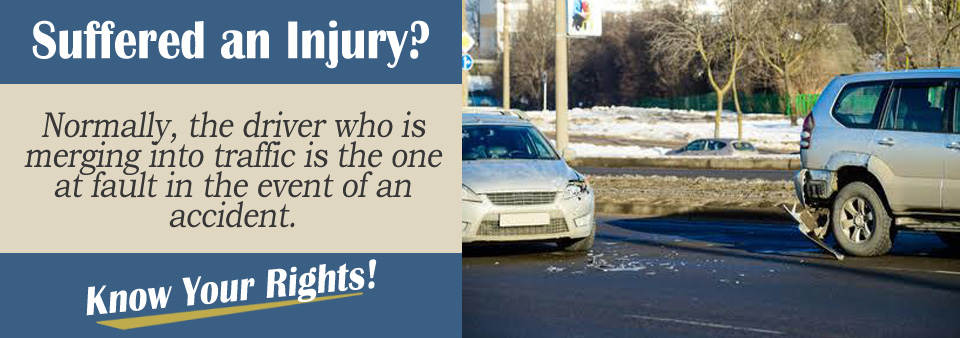Merging onto the Interstate can be dangerous, and accidents regularly happen when one driver merges into another while trying to get onto the highway. Determining fault is key when trying to make a claim for insurance purposes, and knowing who is at fault can be tricky. How do you know who is at fault?
We have asked attorney, Alaina Sullivan, about what you should do. Here is what she had to say:
What Should I Do If a Car Merged Into Me?
A car crash is one of the more jarring and harrowing incidents of your life. If a car merged into you, you may be worried about how you’ll make ends meet while you repair your car or while you’re in the hospital due to injuries from a crash. If another driver merged into you, the first thing you should do is call your insurance company and explain the situation. Hopefully the insurance company remained at the scene, but if not, it’ll be challenging to file a claim.
The next thing you should do after a car merges into you is call a personal injury attorney. A lawyer can help explain your rights as an insured motorist and work to get you a fair settlement for the damages you’re entitled to after a merging accident.
What Causes Lane Change Accidents?
A variety of factors play into lane change accidents. The driver could be distracted with his or her phone, eating, or playing with the radio. Weather often plays a factor with slick roads, rain, snow or heavy fog. The driver could be overly tired or under the influence of alcohol or drugs.
Lane change accidents can occur for any of these external reasons and the results can be devastating.
Who Is at Fault?
Normally, the driver who is merging into traffic is the one at fault in the event of an accident. The reason for this is the driver who is already in the right lane on the highway has control over his or her lane. Merging traffic should not merge until it is safe.
Certain circumstances do exist where the driver who is already in traffic is at fault, but these circumstances are very limited.
Proving Fault
You will need to prove you are not at fault in the accident. If you are the one driving on the Interstate and not the car merging onto the highway, proving fault can be relatively simple. If you were following rules of traffic, and the car merges into you, you can easily show that the merging driver was not following traffic law when entering the highway.
If you are driving in the far-right line of the Interstate and see traffic merging onto the highway, you do have a duty to avoid an accident if it is at all possible. This duty normally means you merge into the inner lane to allow the traffic to enter the highway.
However, this duty does not mean you should recklessly move around in traffic. If it is not possible to merge into the inner lane, you should not attempt to move from your lane.
You similarly have a duty of care to allow the driver in if possible. If you see a car attempting to merge, do not speed up to prevent them from entering safely. Behavior like this can be considered negligent, if not reckless, and the other driver may be able to prove that you were at fault or at least partially at fault.
Comparative Fault
Many states do have a comparative fault law meaning that fault can be divided up in percentages based on the amount of fault each driver’s behavior played into the accident. If the driver merging on the highway did not look while he or she was entering the Interstate, the driver will obviously be found at fault and negligent.
If, however, you saw the driver coming onto the Interstate, saw you could easily move over to let them in but sped up to avoid letting them in, then you may share some percentage of fault in that situation. Your compensation would be reduced by that amount, the percentage with which you were at fault.
How to Prevent Merging Accidents
When out driving on busy roads where merging in and out of traffic is a reality that cannot be avoided, it is important to use turn signals so other drivers know what you are doing. It alerts drivers who may not be fully concentrating on what is happening on the road.
One key feature of merging successfully is merging gradually and not suddenly deciding you are going to merge. This sort of maneuver could scare affected drivers and they may not react in quite the way you would think and may become a danger to other road users.
If you are in a hurry to change lanes one thing you should avoid doing at all costs is tailgating. You don’t know about the traffic conditions ahead of you and if the vehicle in front of you has to slow down suddenly you could end up being the cause of a rear end collision.
Taking Charge in a Merging Accident
If you have been involved in a merging accident and it wasn’t your fault but you were injured and your car was damaged you may be able to file for a personal injury claim against the driver who caused the merging accident.
In the majority of merging accidents, the driver at fault tends to be the one who was merging when the accident took place. This is not always the case and if the merging vehicle collides with a speeding vehicle the merging driver might not be considered liable for the accident.
This could be because the speeding driver prevented the merging driver from estimating the time required to merge. Another such incident is if the merging vehicle is being driven in the inside lane and moves into the middle lane and hits a vehicle which is merging into the middle lane from the outside lane the driver who is merging may not be liable for the accident.
If you are not sure where you stand in a merging accident you should seek help from a personal injury lawyer who will look at all the evidence and help you to file a personal injury claim in your favor. You will need evidence to prove you were not the cause of the merging accident such as:
- Eye witnesses reports;
- Police report;
- Photographs taken at the accident scene;
- Video camera footage if available.
Contact an Attorney Today
you have been injured and your vehicle damaged in a merging accident which you know you did not cause, it is in your best interest to hire a PI attorney to help you file a PI claim. You are likely suffering unexpected financial hardship due to the accident but with the help of an attorney a successful personal injury settlement will help to bring your life back together.
A PI attorney has your interests to consider and will ensure all evidence you provide related to the cause of the accident cannot be disputed. S/he will have a considerable amount of experience negotiating PI claims with insurers. If you try to negotiate on your own you could have your claim denied.
This is far less likely to happen if you have a PI attorney representing you. The attorney will ensure you get all your medical treatment paid for, any wages lost while you are unable to work and an amount for pain and suffering calculated by considering the pain and discomfort you have had to endure in a merging accident that was not your fault.

